Death, Graves and Funerary Architecture
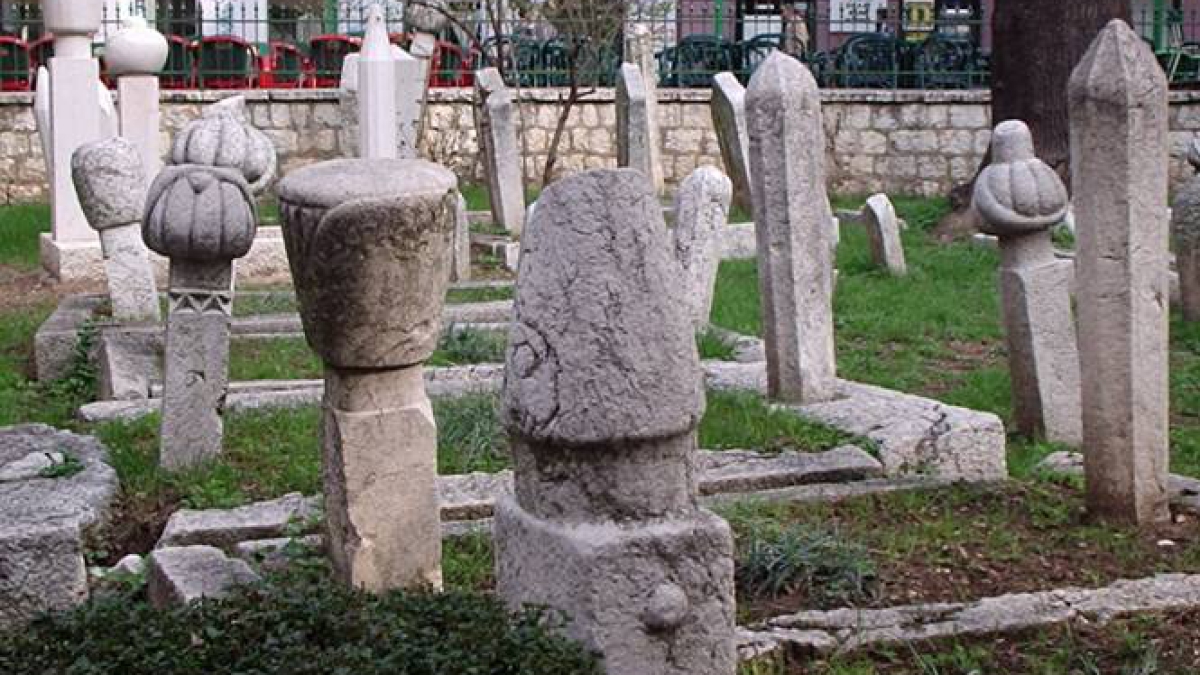
According to the Islamic worldview, this life is a brief journey necessary for arriving to the Hereafter. Death is seen as the gateway to the Hereafter. Death is by no means a negative thing. Believers are scared neither of death nor of the prospect of experiencing it themselves, as it brings them back to Allah, their Creator and Master. To believers, death is the gateway to everything they have patiently longed for in the earthly life. Thus, constantly reflecting on death and looking forward to facing it is considered a virtue; the opposite is viewed as a serious spiritual failing.
Believers do not fret over death as such. Rather, they fret over it because of their unceasing concerns about whether they have done enough, or not, so as to assure themselves salvation. Believers are the most pragmatic lot. They do not live this life obsessed with baseless and meaningless reveries and dreams. They dream but do not end up being just dreamers. They live in reality, not illusion. Their endless exertions target demystifying prevailing but fictitious life ambiguities, deceits, whims and fads, generated by non-belief and sin, most of which center - certainly not by chance -- on the meaning and purpose of life and death. Believers do not wish to be taken unawares once death as the second most compelling reality - the first one being life itself - inevitably strikes. As they live life with neither fear nor sorrow, they likewise want to conclude it with neither regrets nor guilty conscience.
When the appointed time of one's death comes, the Angel of death takes one's soul. No sooner does that very moment come about than one starts living through the results of his actions and exploits performed in this world. Every condition that one is bound to undergo thereafter in the spiritual world is determined only by what provision one has sent forth from the terrestrial life. The whole process culminates in sending one to either Paradise (jannah) or Hellfire (jahannam) on the Day of Reckoning. It is thus rightly said that this world is a field or a ground for the Hereafter. In the latter we reap what we sow in the former.
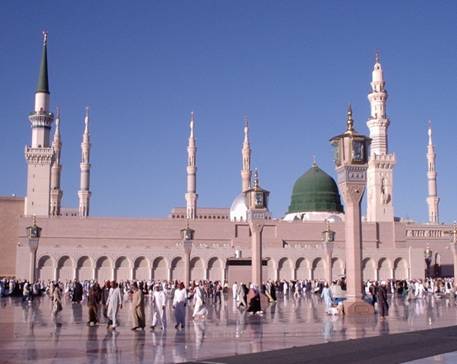 |
| Prophet Muhammad's mosque in Madinah seen from the qiblah side. Under the green dome lies the Prophet's grave |
When in the grave, there are extremely few links between the deceased and this world, thanks to which one's position in the grave can be further improved or even aggravated. But one must always bear in mind that this is possible only on the strength of one's achievements on earth alone and never on the strength of somebody else's unjustifiable intervention or intercession. The existence of the nominal links between this world and life in the grave is to be viewed as a manifestation of Allah's immeasurable mercy over man, on the one hand, and as a manifestation of Allah's infinite and omnipresent justice and care that underscore the human existence paradigm, on the other. The three sources from which one can amplify one's rewards following one's demise, as revealed by the Prophet (pbuh), are: leaving behind a long-lived charity (sadaqah jariyah), knowledge from which people derive benefit, and upright descendants who will offer prayers for a person. (Sunan al-Tirmidhi) It goes without saying that the procurement of those three supply lines is possible purely due to one's own efforts and performances while in this world. It is plausible that just as a person's good deeds are recorded even after his death, so long as the effects of his good and moral acts persist on earth, similarly a person's bad deeds are recorded even after his death, so long as the effects of his bad and immoral acts persist. Indeed, In Islam there are no shortcuts to spiritual excellence and perfection. Allah thus decrees: "Namely, that no bearer of burdens can bear the burden of another; that man can have nothing but what he strives for; that (the fruit of) his striving will soon come in sight; then will he be rewarded with a reward complete." (al-Najm, 53:38-41).
Since the subject of death is not in the slightest a depressing thing in Islam, neither is the subject of graves and graveyards. Muslims are allowed, yet encouraged, to visit graves for the reason that the same reminds them of the Hereafter and compels them to think about the real meaning of life and its inevitable end. Visiting graves for genuine purposes keeps one's feet firmly on the ground. It signifies an antidote for spiritual lethargy, heedlessness, insensitivity and egotism By this tenet, both men and women are covered, as they are all in need of the advantages entailed therein. The Prophet (pbuh) once said: "I prohibited you from visiting graves, but now you may visit them; it will remind you of the Hereafter." (Sahih Muslim) A companion Abu Hurayrah reported that the Prophet (pbuh) visited his mother's grave and cried, and everyone there cried with him. Then the Prophet (pbuh) said: "I sought my Lord's permission to seek forgiveness for her, but He did not permit me. I then sought permission to visit her grave and He permitted me to do this. You should visit graves, because they will remind you of the reality of death." (Sahih Muslim)
 |
| Badr al-Jamali's tomb-mosque in Cairo, Egypt |
However, visiting graves under certain conditions could be a very hazardous thing. So disastrous can it be that a single visit to a grave or a graveyard is able to contaminate one's faith with elements of infidelity or polytheism. Even a single visit, yet a single declaration, can render one's faith virtually null and void. It was because of this, without a doubt, that the Prophet (pbuh) paid much attention to the subject of graves, thus bequeathing a rich legacy to his followers in that particular regard. His numerous actions and statements account for a set of comprehensive, thoughtful and strict guidelines as to every aspect of such a critical issue as managing and visiting graves, which true believers cherished all through the long and colorful history of Islam and Muslims, and will cherish till the end of time. The Prophet (pbuh) thus sternly forbade, for example, rejoicing or conducting celebrations at graves, collective expressions of grief, conducting specific religious rituals, conducting prayers, praying or supplicating to the dead regardless of who they might be: prophets, saints, scholars, heroes, etc.
Furthermore, Islam proscribes building edifices over graves for whatever reasons, more so if the edifices built are meant to venerate the dead and their legacies or to function as places of worship. Although the Prophet (pbuh) said that the whole earth has been created pure and as a place of worship (masjid) to Muslims, (Sahih al-Bukhari) he made three exceptions to the canon: graveyards, bathrooms and places where camels lie down. At these three places prayers cannot be performed. Even to mark graves with some excessively discernible features in absence of valid justification is deemed too detrimental to be admissible. Architecturally memorializing the dead is much more strongly interdicted in public burial areas than in areas belonging to private individuals because in doing so, apart from wasting time and depleting resources, the availability of spaces for other graves is trimmed down and the free movement of such as come to visit graves can also be affected. More than a few reasons for this unyielding Islamic position could be given, the most important of which, certainly, is the close relationship between exalting and architecturally glorifying graves and rearing the causes that may possibly lead to associating other deities with Almighty Allah. Other reasons are related to misusing either private or public resources on insignificant and unbeneficial things, trends of unhealthy rivalries and schism, obscuring and weakening one's understanding of and relationship with the metaphysical world, opening doors for a great many religious innovations (bid'ah) to establish themselves and thrive. Finally, the graves in question are set to somewhat fail in their fundamental duty of reminding people of death and the Hereafter. Instead, they with various structures over or near them will be bent on drawing attention to and indirectly promoting, so to speak, this world and its false multifaceted pomp and splendor. In other words, such graves become both spiritual and physical liabilities to society.
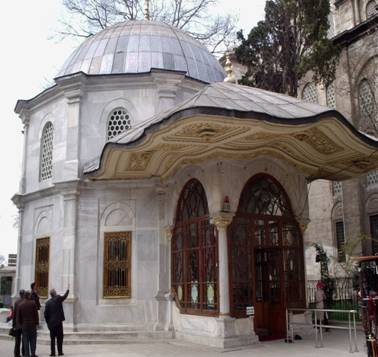 |
| The mausoleum of an Ottoman Sultan Mehmet al-Fatih in Istanbul, Turkey |
On one occasion after he had been told of the beauty of a Christian church in Abyssinia (Ethiopia) and how wonderful its paintings were, the Prophet (pbuh) observed: "Those people are such that if a pious man amongst them died, they build a place of worship over his grave and paint these pictures in it. Those people will be Allah's worst creatures on the Day of Resurrection." (Sahih al-Bukhari)
The Prophet (pbuh) cursed such persons who build mosques over graves and light up graves. (Sunan Abi Dawud) Moreover, sitting on graves, reclining, leaning or sleeping on them, walking over them, urinating and defecating on or between them is likewise undesirable. The Prophet (pbuh) has said that it is better to sit on an ember which will burn the clothes and get to the skin than to sit on a grave. He once spotted a man leaning on a grave, whereupon he told the man: "Do not disturb the one inside the grave." (Ibn Qudamah's al-Mughni)
It is blasphemous if graves are kissed, prayed towards them, or touched for the sake of procuring blessings (barakah) or for any other phony spiritual purpose. More blasphemous, however, is praying to the dead, seeking from them guidance, inspiration, intercession or healing power, praying to God through them, circumambulating their graves, and the like. In brief, anything apart from intending to help the dead by offering supplications (du'a) to God for them, and apart from intending to benefit one's own self by pondering over death, the secrets of life, and over the Hereafter, is deemed a depraved and thus an objectionable act.
It is almost impossible to determine the actual commencement of practicing excessive and popular grave veneration, as well as the culture of building tombs, mausoleums and shrines in Islamic civilization. Yet, it can be contended that the matter did not, and could not, materialize until disunity and schism at various levels of the Muslim presence, coupled with the people's manifest erosion of faith, set out to cripple the Muslim community (ummah). This contention rests on the fact that the relationship between the two phenomena is causal, the people's impiety and divisions always being the direct and most blameworthy cause of the practice of building and institutionalizing funerary edifices and idolizing those in whose names they had been established, as proven time and again throughout the history of human society. So, the time that witnessed the first grand mausoleums and shrines in Muslim history being freely built on the Muslim soil could approximately be the middle of the 4th AH/10th CE century when disintegration of the caliphate, and with it disintegration of many a religious institution and establishment, was like never before in ascendancy and was approaching its apogee.
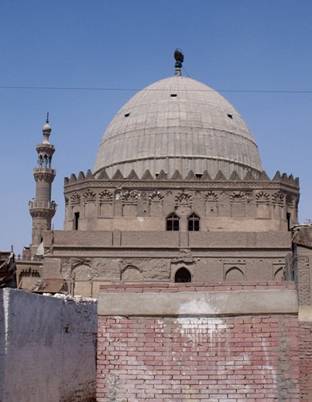 |
| The mausoleum of Imam al-Shafi'i in Cairo |
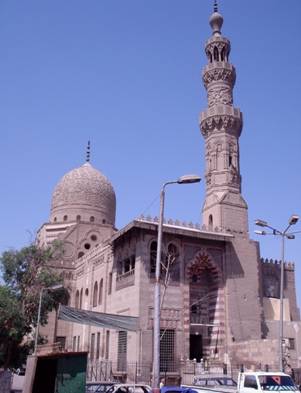 |
| The funerary complex of a Mamluki Sultan Qaytbay in Cairo |
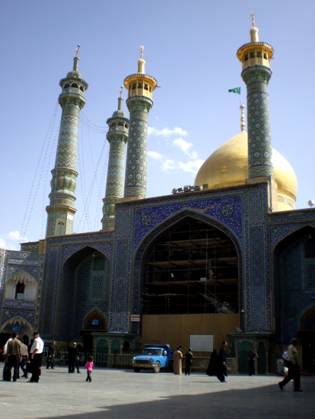 |
| Fatimah al-Ma'sumah Shrine in Qom, Iran |
Nevertheless, it is widely held that the first known mausoleum in Islam was built in Samarra, once the Abbasid capital in Iraq. Its name is Qubbah al-Sulaybiya and was built for the Abbasid caliph al-Muntasir who died in 248 AH/ 862 CE. It is said that the caliph's Christian mother had asked for and obtained permission to have a tomb built for her son. However, some time was still needed for the innovation to take off as a trend. As for the practice of associating a tomb, usually of the founder, with a mosque, it is generally accepted that it began in 479 AH/ 1085 CE with Badr al-Jamali, a Fatimid military commander, whose tomb-mosque on Mount Muqattam overlooking Cairo set the first example.
Of a number of responsible parties, certain segments of the Shi'ah orb contributed perhaps the biggest share to the institution and proliferation of the idea of graves veneration, as well as the idea of erecting funerary edifices over graves, both at the theoretical and practical levels. The same idea was maturing with the maturation of certain Shi'ah doctrines -- especially those connected with the notions of the Prophet's family, Imams and saints and their own families -- and was expanding with the expansion of the Shi'ah faction and its ideology. The nature and intensity of age-long Shi'ah-Sunni confrontations, both on physical and ideological planes, further inflamed the whole thing, prompting some Sunni protagonists to resort to the same strategy firstly as expediency but later, when other socio-political and religious factors came to the fore, as principle. With its establishment and rise, the epidemic of graves exaltation and building mausoleums and shrines before long was able to affect the minds and souls of those in many parts of the Muslim world who had abandoned some vital aspects of pristine Islam and thus were in dire need of a conjured shortcut substitution and supplement.
It would be a grievous mistake to assert that the inclusion of the Prophet's grave into the Prophet's mosque proper in Madinah served as an "incidental" inauguration of the custom of burial in mosques, following which the thing - as well as other forms of architecturally glorifying particular dead persons - started to evolve never showing signs of slowing down. What actually happened is that the Prophet's grave at first stayed outside the mosque, inside the house of A'ishah, the Prophet's wife, as dictated by a divine arrangement. But after the first and best generation of Muslims had successfully set the standards of treating the grave of their Prophet (pbuh), and after the stage had become set for some new generations with a new mentality, but surely with a weaker faith, to take over, the grave entered under the guardianship of the community (ummah). Aptly, it entered the domains of the ummah's principal mosque in Madinah, on account of the Prophet's mosque having always been, together with the Ka'bah and al-Masjid al-Haram in Makkah, the ummah's conspicuous quintessence and soul. The grave's authentic role and position were thus forever secured, for the ummah as a whole shall never and under no circumstances agree on an error. Once under the aegis of the ummah, with its religious and intellectual leadership in vanguard, every fallacy or transgression in relation to the Prophet's grave could easily be checked and, while in its infancy, effectively done away with. In the same vein, by virtue of being the two most revered personalities in Islam after the Prophet (pbuh), companions and first two caliphs, Abu Bakr and Umar b. al-Khattab, whose graves adjoined the Prophet's grave, merited to gain entry under the guardianship of the ummah as well.
As regards all the major causes for the institution and proliferation of funerary architecture in Islamic civilization, they were plentiful, often intertwined. The most important ones were as follows: the Shi'ah factor; desperate promotion of Sunnism; several Sufi beliefs and principles; weakening role of the scholars ('ulama); some foreign elements and influences; perennial political rivalries among Muslims; the concept of tawassul (seeking the means of approach unto God) and its misinterpretation; some desperate da'wah (calling people to Islam) means and strategies; and Islamic outright support for visiting graves and some people's abuse of that concession.
All these reasons notwithstanding, it must be said that no matter how widespread the existence of funerary architecture in Islamic civilization has been, and no matter how great the number of surviving funerary monuments testify to it, yet this by no means implies that no sooner had the idea of architecturally glorifying the dead been instituted inside the Muslim circles than Muslims, as a community and cohesive entity, en masse set out to violate some of the weightiest precepts decreed by Islam. It is true that building funerary monuments after the 4th AH/10th CE century was an expansive occurrence. But we have to bear in mind that the same, by and large, remained intermittent with respect to the existence and gusto of the phenomenon's instigators, patrons and supporters. There was never a time when building shrines and mausoleums was carried out with the same intensity and enthusiasm in more than a few regions. Never was the entire Muslim land home to the vice. In regions where the tradition was very popular, even there upholding it remained a drill of a group, large sometimes and in some parts, but small and even nonexistent at other times and in other parts.
This article is an excerpt from the author's book "Death, Graveyards and Funerary Architecture in Islam": http://www.islamicbookstore.com/b10044.html
*****
Dr. Spahic Omer, a Bosnian currently residing in Malaysia, is an Associate Professor at the Kulliyyah of Architecture and Environmental Design, International Islamic University Malaysia. He studied in Bosnia, Egypt and Malaysia. His research interests cover Islamic history, culture and civilization, as well as the history and philosophy of the Islamic built environment. He can be reached at spahico yahoo.com; his blog is at www.medinanet.org.





